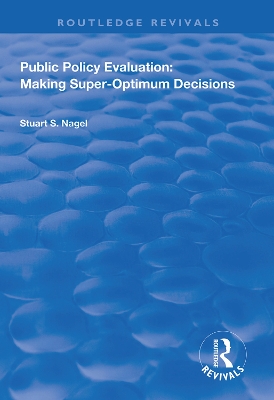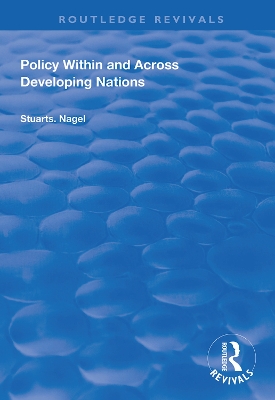Routledge Revivals
4 total works
First published in 1998, this volume examines how super-optimum decisions involve finding alternatives to controversies whereby Conservatives, Liberals, or other major groups can all come out ahead of their best initial expectations simultaneously. This book is organised in terms of concepts, methods, causes, process, substance, and the policy studies profession. Concepts clarify that policy evaluation traditionally involves: (1) Goals to be achieved; (2) Alternatives available for achieving them; (3) Relations between goals and alternatives; (4) Drawing a conclusion as to the best alternative in light of the goals, alternatives, and relations; and (5) Analysing how the conclusion would change if there were changes in the goals, alternatives, or relations. Super-optimizing also involves five related steps, but with the following improvements: (1) Goals are designed as conservative, liberal, or neutral; (2) Alternatives get the same designations; (3) Relations are simplified to indicate which alternatives are relatively high or low on each goal; (4) The conclusion involves arriving at an alternative that does better on Goal A than Alternative A, and simultaneously better on Goal B than Alternative B; and (5) The fifth step involves analysing the super-optimum or win-win alternative in terms of its feasibility as to the economic, technological, psychological, political, administrative, and legal matters.
Creativity and Public Policy: Generating Super-optimum Solutions
by Stuart S. Nagel
This title was first published in 2000: A history of the ideas behind public policy studies, which can be defined as the study of the nature, causes and effects of government decisions for dealing with social problems.
First published in 1998, policy WITHIN developing nations includes: (1) Economic policy, such as economic growth without inflation or sectors of unemployment; (2)Technology policy, such as encouraging the ad option of improved technologies for health, energy, transportation, agriculture, manufacturing and the environment; (3) Social policy, such as education facilities, and merit treatment across ethnic groups, genders, age groups, economic classes, and geographical regions; (4) Political policy, such as multiple sources of ideas from different government levels, branches, interest groups, and parties; (5) Legal policy, such as compliance with the law by street people, business people, and government people. Policy ACROSS developing nations includes: (1) International economic policy, such as trade, tariffs exchange rates, and factory relocation; (2) International technology policy, such as patents, copyrights, trademarks, and other aspects of technology transfer; (3) International social policy, such as immigration, refugees, and cross-border ethnic friction; (4) International political policy, such as human rights and the role of sanctions; (5) International legal policy, such as the drug trade, human rights, business transactions, torts, and property rights across national boundaries.
This title was first published in 2000. Super-optimizing analysis deals with public policy problems by finding an alternative that enables conservatives, liberals and other viewpoints to come out ahead of their expectations simultaneously. This text explores the ideas and seeks to make super-optimum solutions a matter of routine.



